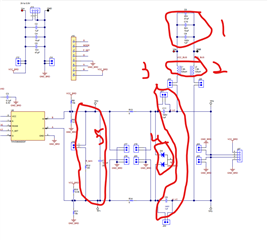Other Parts Discussed in Thread: THVD8010, THVD8000, THVD8000EVM
Tool/software:
Hi , Team
In order to pass EMC test, customer want to add C1,C2, L1,PTC1,PTC2 as the follow picture, do these devices affect the normal work of SN65HVD3082?

BR
Jingguo
This thread has been locked.
If you have a related question, please click the "Ask a related question" button in the top right corner. The newly created question will be automatically linked to this question.
Tool/software:
Hi , Team
In order to pass EMC test, customer want to add C1,C2, L1,PTC1,PTC2 as the follow picture, do these devices affect the normal work of SN65HVD3082?

BR
Jingguo
Hi Jingguo,
The start and end node should be terminated with 120 ohm resistors - that should be first priority because if that is not done you will create potential EMI issues.
That being said:
1. Common mode choke is fine to use
2. C1 and C2 - probably okay - but since they add capacitance to ground you do reduce the maximum frequency and length of system - 100pF isn't that bad, but the more nodes you add to the bus the worse it may be. The device they are using is pretty slow though so the risk is minimal - but the max bus length could be impacted depending on data rate.
3. The fuses are fine most likely - they can add up to 16 ohms of series resistance though which will reduce max effective bus length.
So ultimately - these could be used - but it will impact max bus length and maximum frequency you can use - what that number is depends on the system setup (cabling used, how many nodes with this setup are used, is the system terminated (it should be if EMC concerns are there as you don't want data signal or harmonics causing issue). The tradeoff to these is that it limits max bus length (capacitors, fuses, and maybe a little from the choke - but not too bad there) as well as max bus frequency (capacitors).
Please let me know if you have any other questions!
Best,
Parker Dodson
Hi Parker,
Many thanks for your reply, if using THVD8010, Do we need add the same EMC circuit with 485?
BR
Jingguo
Hi Jingguo,
The EMC circuits are not required for any RS-485 system, that also includes the THVD8010/THVD8000 as well.
That being said a few things to note:
1. THVD8010 has a specific system setup that must be met before additional EMC circuitry is added - this is the going to include the coupling network - a quick overview is shown below - I am using a schematic snippet from the THVD8000EVM - but the design theory is exactly the same for the two devices.

1.1) Point 1 is the bulk capacitance for the power supply - this is required to mitigate OOK noise on the power nodes
1.2) Point 2 are the coupling inductors - these are used to block OOK data from teh power nodes but allows a power signal to enter the shared bus.
1.3) Point 3 are the series capacitors -they block DC / Low frequency AC power signals while allowing OOK data to pass through relatively unaffected.
1.4) Point 4 is is the protection diode - while not required highly suggested to protect the communication node
1.5) Point 5 is the termination - the 120 ohms is required for the first/last node on the bus with middle nodes unterminated. The differential capacitance is optional - but can be added to add some additional filtering to the differential bus.
2. If all those 5 points are set in the system - then you can think of adding a few more items - I will start with the most suggested to least suggested:
2.1) Split termination - as described in my first reply is a filtering technique that has very little negative trade-offs with performance. Biggest issue would be additional BOM cost and increased solution size -but generally it is well worth it to pursue adding this.
2.2) Common mode choke - these generally are seen in a lot of THVD8000/THVD8010 applications as it doesn't cause too much negative impact on bus but does help a lot with filtering.
2.3) Additional filtering capacitance can be used beyond what is listed - but generally for the THVD80x0 devices I would advise doing that unless absolutely necessary because - even though this part is "slow" it actually isn't and has one of the fastest transition times of any RS-485 device.
Please let me know if you have any other questions please let me know!
Best,
Parker Dodson